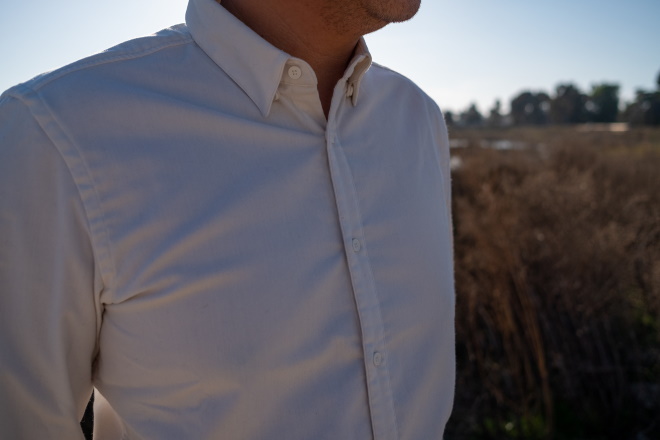This Travel Shirt Has Got Me Thinking About Flannel
Last week I complimented a co-worker on her Fall outfit – blue jeans, boots, and a flannel top. The weather in this area is pretty temperate but with a pretty hot summer, it was a nice reminder that we are starting to finally see colder weather here in California.
We’re all familiar with flannel and may even own one or two pieces but I think it’s a piece in our wardrobe we give very little thought to. Pop quiz: what is flannel? A pattern or is it a material? I think most would agree it’s a material and it’s one we can instantly recognize, if not visually, then definitely upon touch. But what makes it special and is there any way it can be improved?

Some would argue that flannel must be made from wool that is first tightly woven then woven into a dense fabric then brushed to give that soft fuzzy look we all love. Will Watters and the team at Western Rise are experts in fabrics and huge fans of wool. However, when they set out to see if they could give flannel some properties that would make it more durable than standard Merino wool, they realized that they had a large challenge ahead of them.
First, they wanted to give their flannel the stretch that users expect in a versatile piece of travel clothing. To do this, they tried to marry wool with Spandex or another elastane fiber to create a blended yarn. This worked and is actually fairly common in lots of modern wool pieces. However, flannel is not just wool alone; instead it requires a certain handfeel or loft. To achieve that, the team at Western Rise needed to brush the blended yarn to achieve the flannel fabric, and the elastane fibers broke.

After working endlessly with their partner mills and suppliers, they were able to figure out a solution: they found a fabric that combines elasterell polyester with CoolMax (a material with hollow cores which mimics the performance of Merino wool), and to top it all off, they added in small amounts of Merino.
What you get is the heft and “weight” of flannel, the brushed feeling, and the warmth but with the added benefits of stretch and odor resistance. With that said, if you can accept that this TechWool Flannel shirt is not flannel in the traditional sense (neither the pattern nor purely wool), then read on to hear my thoughts as I wore it this most recent winter.

Upon receipt, I was really impressed at how close to traditional flannel the TechWool shirt was. It definitely had that brushed feeling against your skin as you wear it and anyone running their hand against your back or arm would immediately be reminded of flannel. It also has that thickness that you don’t really get in a normal Merino t-shirt or base layer. However, it feels much lighter and a little bit thinner than many flannel shirts I’ve used. I have always worn it as a base layer but you should really treat it as a mid-weight base. Depending on your sizing, I could imagine putting a very thin base underneath such as a Uniqlo HEATTECH or a Patagonia Capilene shirt, if you tend to run cold.

With the more rigid material, you get some benefits such as structuring. I am a big fan of Merino but some of the elements that make it so good (such as the light weight to warmth ratio), make it not the greatest fabric for shirts that require a certain shape – such as dress shirts, polos, or button-up affairs. With the TechWool Flannel shirt, Western Rise was able to take advantage of the slightly beefier material to construct elements like a collar that stays put, cuffs that stay confident around your wrists, and a button column that stays defined.

The shirt hides a big secret by way of the special fabric and processes used to construct it, which you are all privy to now. But the surprises don’t stop there. With the sleeves, they added a little bit of flair in there – by way of a one button mitered cuff. This adds a fun bit of sophistication to a shirt that can be dressed up or down. And the collar I mentioned earlier? There’s a hidden button underneath to make sure the points stay flat and don’t curl up. Even the buttons are interesting; they’re rubber coated for ultimate durability while looking remarkably close to high-quality resin buttons you’d find on nice dress shirts.

The athletic fit of the TechWool Flannel shirt means it’s a little slimmer and body-fitting but by no means is it tight or uncomfortable. I am 5’8″ and about 170 lbs (so: not skinny) and the Medium fits me perfectly. I suspect someone with my height and maybe 20 lbs lighter could fit into a Small. The length and sleeve lengths are perfect. The only issue I have is closing the top button but that’s always been an issue for me since I have a large neck. If I wanted to wear a tie, I’d reach for a different shirt.
When you have it on, it’s immediately obvious how advantageous the two-way stretch is and what it brings to the table. You don’t feel restricted moving around and bending my elbows and “hugging” myself is no issue. I wouldn’t wear this shirt for hard labor but it certainly fits the bill as an active item.

It’s a bit of a miracle with what Will and his team at Western Rise have developed. They took a look at traditional flannel, which is such a beloved fabric, and used modern textile techniques and technologies to bring it into the 21st century. If you can’t tell, I am quite enamored with this shirt because it represents exactly what we’ve all been yearning for, for the past 10 years – the gradual replacement of a legacy wardrobe with one that looks and feels like it was drafted by a designer, but constructed in a lab using science. And after having this in my rotation for the past few months, I can highly recommend!
A heads up: we’re supported by our readers. So when you buy through links from Carryology.com, we may earn a small commission, at no cost to you. This helps support us, and allows us to keep investing in our testing, reviews and editorials.
We are also a participant in the Amazon Services LLC Associates Program, an affiliate advertising program designed to provide a means for us to earn fees by linking to Amazon.com and affiliated sites.





 Carry Awards
Carry Awards Insights
Insights Liking
Liking Projects
Projects Interviews
Interviews














